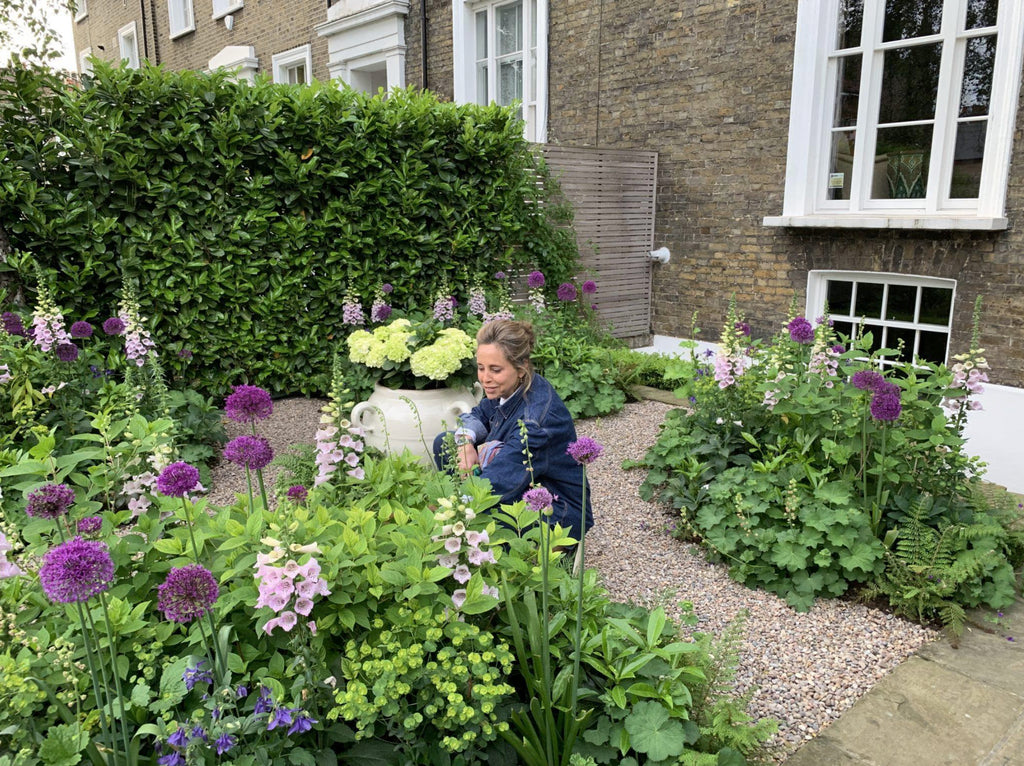In conversation with garden designer and new friend of Rhug Wild Beauty, Butter Wakefield
Posted by TEAM WILD BEAUTY

We are delighted to welcome Butter Wakefield, garden designer, as our latest Friend of Wild Beauty. Butter grew up on a small farm outside of Baltimore, Maryland. Her mother, aunt and grandfather were all keen and accomplished gardeners, and she remembers with great fondness wandering around their beautiful gardens as a child – her deep appreciation of beautiful surroundings and a passion for gardening is a family trait running deep in her veins.
Butter trained at the English Gardening School, winning two prizes, and more recently graduated from The London College of Garden Design with a Merit Commended. Originally, she worked as an interior design assistant at Colefax and Fowler in London where she was trained in the world of decorative interiors. It was there that her love of the creative process took hold as she learned about scale, texture, pattern, colour and the principles and practices of design.
Named RHS Chatsworth Gold Medal Winner 2017 for her Belmond Enchanted Gardens, Butter lives in London where she has a small design studio, specialising in the creation of inspirational and purposeful gardens of all sizes. We recently spent some time chatting to Butter, learning more about her work.
You grew up on the East Coast of America – how do the gardens there differ from those of the UK?
The seasons are more extreme in the States, we have proper frozen ground from December to February in the winter and hot humid weather in the summer. As such, there are places that are too cold for more tender plants. I live in London so I can pretty much garden all year round except for maybe January. I love this! The sky in America can often be bluer in the winter, less grey and murky, but the light here is generally much softer.
You originally trained in decorative interiors – do you find the skills you learnt in that field transfer over to garden design? And, what drew you to garden design?
I learned so much working at Colefax and Fowler; notably the principles of good design: scale, colour, form, pattern, and texture. I think it helped me hugely see everything in a broader, more focused light.
I knew it was time for a change from the inside to the out, when our second baby came along. I yearned to spend more time with my young children and to perhaps march to the beat of my own drum a bit more. After lots of learning, garden design seemed a natural next step for me!
Do you have a signature style that clients come to you for, or do you adapt your style according to the project?
I’d like to think we can accommodate a huge variety of design aesthetics, but love to use traditional materials, from trellis to furniture. One of our particular favourites is to specify small format Belgian bricks, cobbles, and setts to create pattern in the paving. I adore designing densely planted mixed borders, with clipped shapes and lots of flowers and scent for cutting and bringing inside.
When working on a brief, where do you take inspiration from?
I am inspired by all things, but architecture always plays a role at the start. We once designed a gorgeous garden for a charity based on a Rapture and Wright Fabric called Moorish Maze. That was lovely fun!
Do you have a favourite UK garden that you frequently visit?
I know I am not alone, but Great Dixter and Chatsworth always inspire me. Somewhat closer to home, I am a huge fan of Thyme England and Petersham Nurseries.
Which project are you most proud of and why?
We created a garden for a heavenly client in Bayswater called the Ribbon Wheel Garden. It was hugely complicated with lots and lots of circles joined together by a ‘ribbon’ of setts. It won three awards, which made us wonderfully happy and proud.
When it comes to your own garden, it seems like you have transported a little piece of the British countryside to West London. Is it due to an inherent love of the countryside or driven by more ecological reasons?
Like so many, I find my own garden a source of great peace and joy. I am drawn to it like a magnet, and if I am not out in it on both Saturday and Sunday for a big chunk of time, I start the week feeling somehow robbed and a bit disappointed. My wildflower meadow never fails to deliver, there is always something of interest going on out there, and it really has helped me understand the vital role these wildflowers play in our fragile green ecosystem. And yes, I do have an inherent love for the countryside, having grown up on a small farm in the States, but curiously a garden in the city is all I really seem to need to make me feel satisfied and content.
How do you feel sustainability is being addressed in horticulture?
I think everyone in horticulture recognises the importance of sustainability. I try to help my clients understand how they can each play a part (however small) in creating ‘green corridors’ in their own gardens. Frances Tophill’s book ‘Rewild your Garden’ is full of exceptionally clever easy ideas to help provide additional habitat and nectar/pollen for the birds and insects. It is a very good starting place for anyone who wants to do more!
Where is your wild beauty escape?
Weekly, a walk along the River Thames with my Border Terrier helps me to reset. The light on the water and long views somehow coaxes the worries from the working week out of me, making space for creativity and relaxation to seep back in. I couldn’t not live near it.




